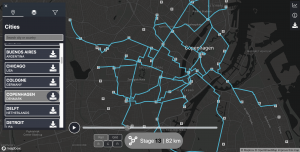Recently we released GrowBike.Net, accompanying our preprint “Growing Urban Bicycle Networks“. The interactive data visualization platform was developed by NERDS Master students Cecilia Laura Kolding Andersen and Morten Lynghede as part of their thesis “Developing an Interactive Visualization of Bicycle Network Growth” with Michael Szell.
GrowBike.Net lets you explore how to grow bicycle networks from scratch in 62 cities worldwide. Choose a city and grow the bike network, connecting places efficiently step by step.
The growth process creates a cohesive bicycle network – something that every modern city should have. Studying these synthetic networks informs us about the geometric limitations of urban bicycle network growth and can lead to better designed bicycle infrastructure in cities. GrowBike.Net also allows to compare the grown networks with your city’s existing bicycle network.
Although our approach here is not yet aiming to provide concrete urban design solutions, it could be useful for planning purposes for easily generating an initial vision of a cohesive bicycle network – to be re-fined subsequently.
The platform also features a media page where over 1000 videos and plots can be downloaded: http://growbike.net/download
Have fun exploring growing bike networks in your city!


